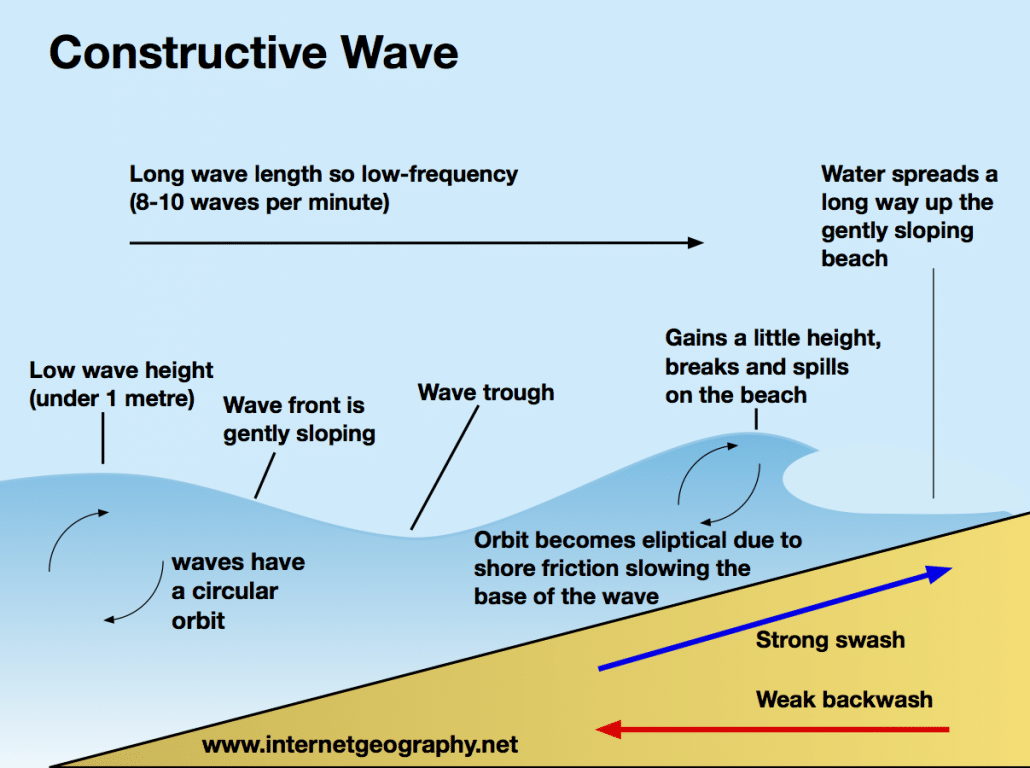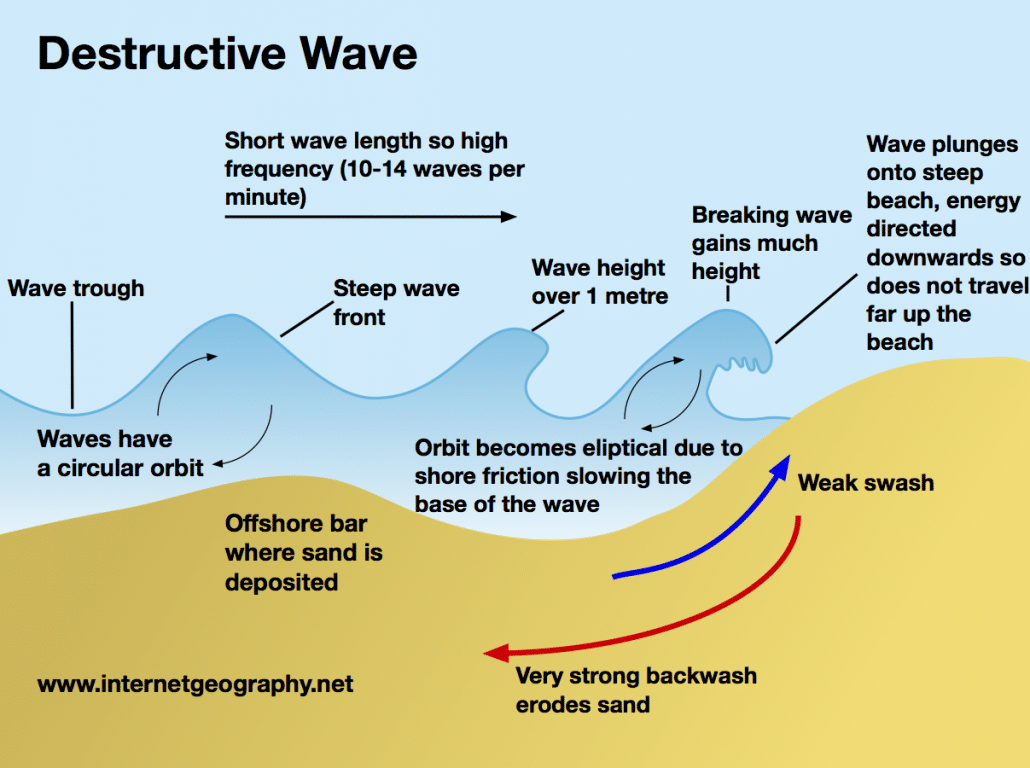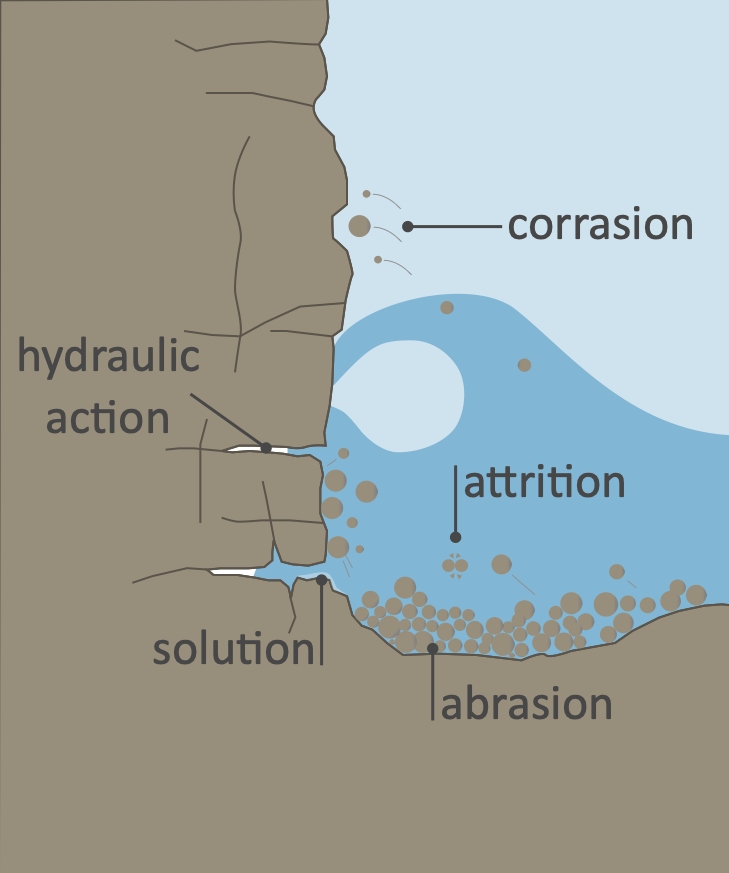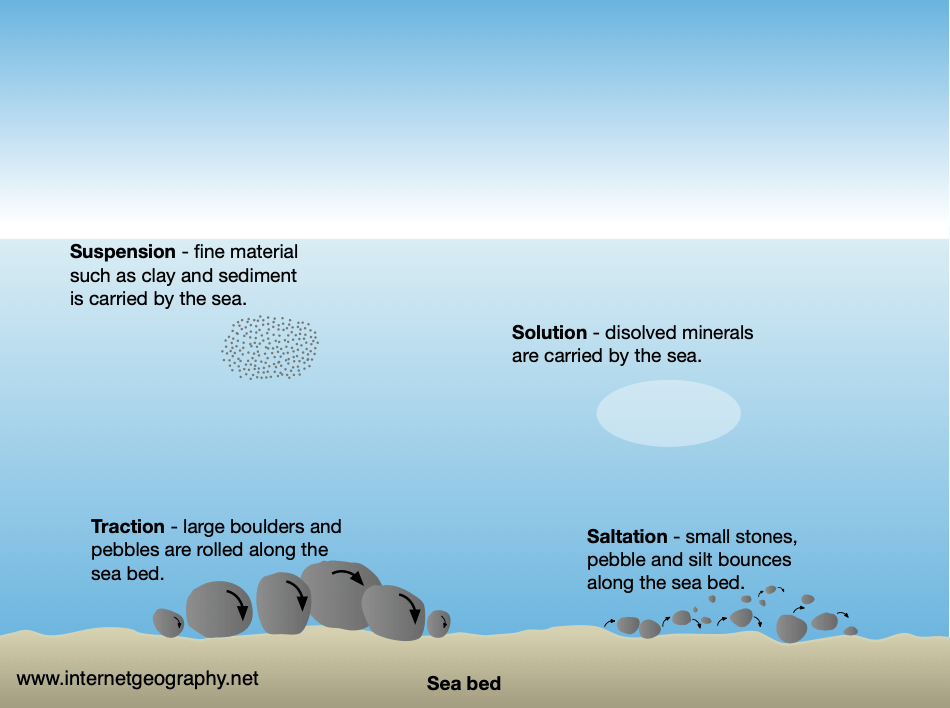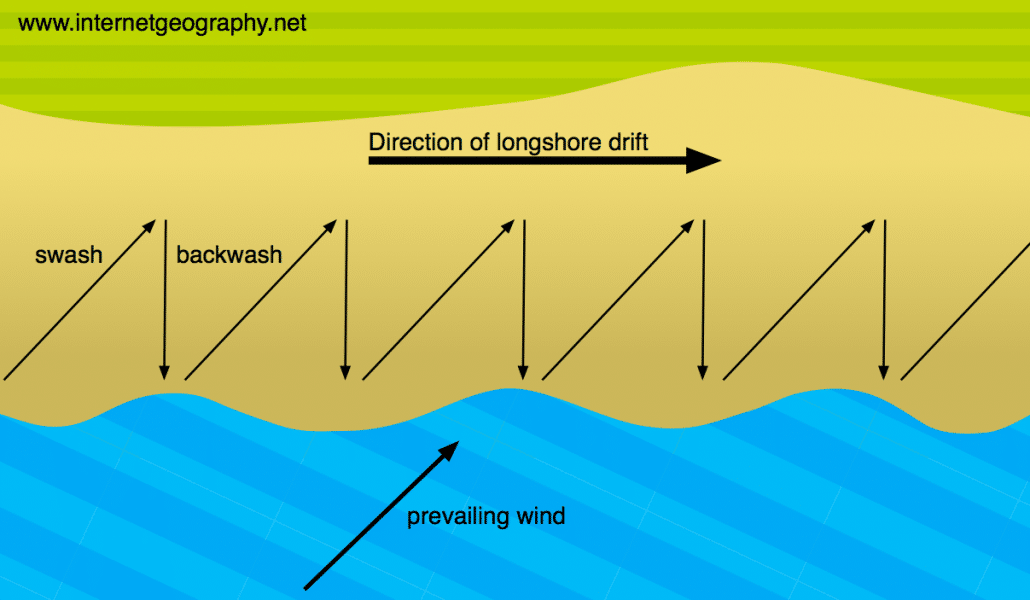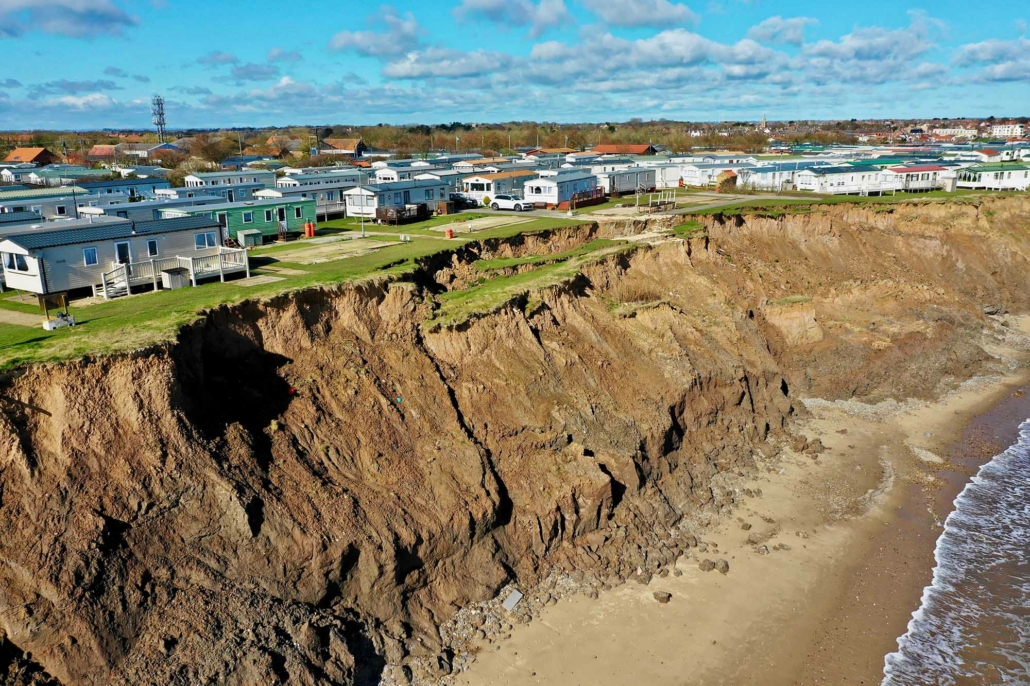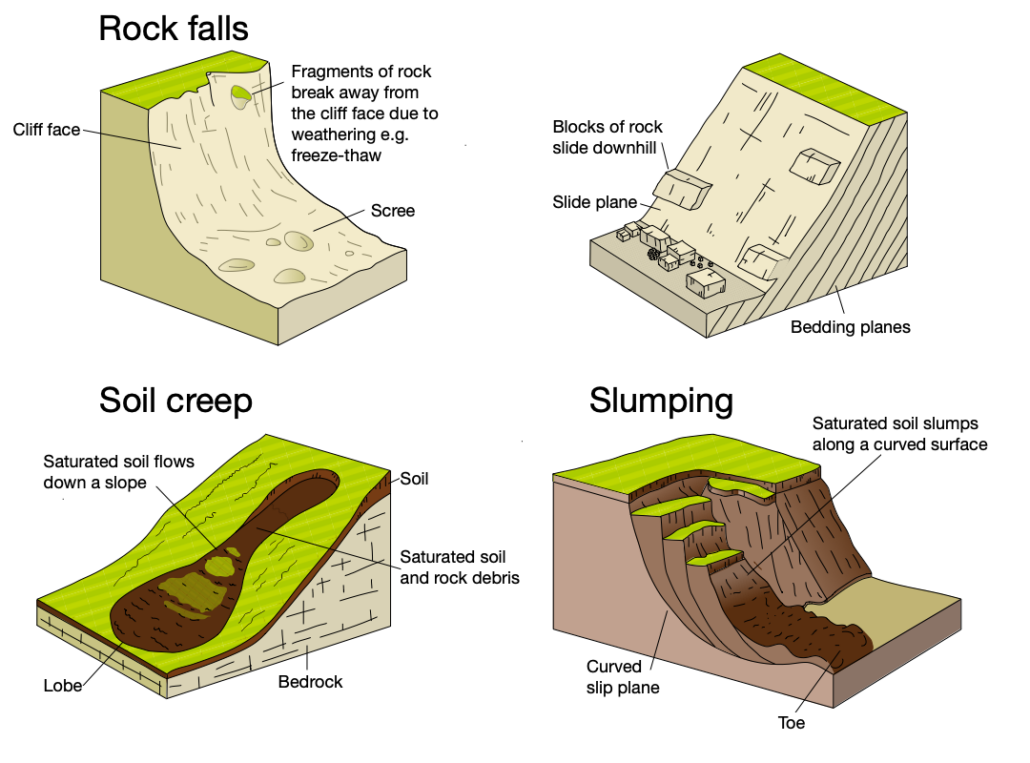Physical Processes in Coastal Areas
Coastal Processes
Coastal zones are a hive of physical activities. These activities are triggered by:
- The combined action of waves, which can be either constructive or destructive, and the wind.
- Natural processes such as mass movement, such as sliding and slumping, as well as weathering, can be mechanical, chemical, or biological.
Waves
Coastal waves, primarily formed by the wind blowing across the surface of the sea, play a key role in shaping the coastline. Waves are usually classified as constructive or destructive based on their characteristics and impacts.
Constructive Waves: Constructive waves, also known as depositional waves, are low-energy waves that add materials to the coastline. They are typically associated with periods of calm weather.
- Height and Length: These waves are usually low in height (less than 1 meter) and long in length. They have a strong swash (the forward movement of water up the beach after a wave breaks) and a weak backwash (the water running back down the beach under gravity).
- Frequency: The wave frequency is typically low, often 6-8 waves per minute.
- Impact: The strong swash carries materials (like sand, pebbles) up the beach, forming ridges. Over time, this leads to the build-up of beach material, contributing to the growth of the coastline.
- Beach Profile: Beaches influenced by constructive waves have a gentle gradient due to material deposition.
Destructive Waves: Destructive waves, also known as erosional waves, are high-energy waves that remove materials from the coastline. They are usually associated with stormy conditions.
- Height and Length: These waves are high (often over 1 meter) and short in length. They have a weak swash and a strong backwash.
- Frequency: The wave frequency is high, often 10-14 waves per minute.
- Impact: The strong backwash carries beach material away, eroding the coastline. Over time, this can lead to cliff collapse, coastal retreat, and other forms of coastal landform changes.
- Beach Profile: Beaches influenced by destructive waves have a steep gradient due to the removal of material.
Processes of Coastal Erosion
The erosional power of waves can be attributed to four key processes: hydraulic action, abrasion, attrition, and solution.
Hydraulic action is a type of coastal erosion that occurs when the force of waves crashing against a cliff or other rocky coastline compresses air in cracks and crevices. When the wave retreats, the compressed air explosively decompresses, acting like a small jackhammer on the rock. Over time, this repeated hydraulic action can cause rocks to break apart and cliffs to collapse.
Abrasion is a type of coastal erosion that occurs when waves carrying sand, pebbles, and other sediment, strike the shoreline or cliffs. The friction from these materials hitting the land is similar to the action of sandpaper, which gradually wears away the rock.
Corrasion is when waves pick up beach material (e.g. pebbles) and hurl them at the cliff face, causing erosion.
Coastal attrition is a process of coastal erosion where wave action causes rocks and pebbles that the sea carries to collide, gradually wearing down and rounding these materials. Over time, these fragments are reduced in size and become smoother due to the continuous impacts. The process of attrition contributes to the production of sand.
Solution is a process where certain types of rocks, notably limestone and chalk, are dissolved by the acidity in the seawater.
Processes of Coastal Transportation
Particles within the water are transported in various ways:
- Larger particles are moved by traction, a process where they are dragged along the seafloor.
- Saltation causes smaller particles to hop or bounce along the seafloor.
- Very fine materials float and move in suspension.
- Sediments in a dissolved state, like calcium, are carried in solution.
Processes of Coastal Deposition
Deposition is a process that happens due to several factors:
- A decline in the energy or velocity of waves.
- A substantial availability of material.
- A coastline with an irregular pattern, for example, around river mouths.
Wave Refraction and Longshore Drift
The Effects of Wave Refraction and Longshore Drift Wave refraction is the bending of waves as they approach a non-uniform coastline or come at an angle that is not perpendicular to the shore. This bending reduces wave velocity and can cause waves to break parallel to the shoreline when it’s complete. It channels wave energy towards the sides of headlands while spreading it out in bays. However, since refraction is rarely complete, longshore or littoral drift occurs. The swash refers to the upward motion of water on the beach, while the backwash is the downward motion.
Coastal Weathering and Mass Movement
Weathering and mass movement occur on coastal cliff faces.
Weathering
Weathering is the physical and chemical breakdown of rocks and minerals in situ (in the place where they are) at or near the Earth’s surface. At the coast, the combination of ocean and atmospheric conditions contributes to several types of weathering:
Mechanical (physical) weathering
This process involves the physical disintegration of rocks without any change to their chemical composition.
- Salt Weathering: This form of mechanical weathering is prevalent in coastal regions. As seawater splashes onto rocks, it evaporates, leaving behind salt crystals. As these crystals grow, they pressure the rock, causing pieces to break off.
- Freeze-Thaw Weathering: This occurs in coastal areas with fluctuating temperatures above and below freezing. Water enters cracks in the rocks, freezes (expands), and then thaws (contracts). This continual freeze-thaw cycle widens the cracks, causing rock fragments to break off over time.
Biological weathering
This type of weathering happens when living organisms contribute to the breakdown of rocks. For example, plant roots can grow into cracks in rocks, expanding them and causing pieces of the rock to break off. Burrowing animals and microorganisms can also cause rocks to weaken and disintegrate over time.
Chemical weathering
This process involves the transformation of rocks due to chemical reactions.
- Hydration: This occurs when water reacts with minerals in the rock, causing them to expand and eventually disintegrate. An example is the transformation of anhydrite into gypsum.
- Oxidation: Oxygen from the air or dissolved in water can react with some minerals in rocks, such as iron, leading to the formation of new minerals (like iron oxide or rust) and contributing to the rock’s breakdown.
- Carbonation: This process involves carbon dioxide dissolving in rainwater to form weak carbonic acid. It can react with minerals in rocks like limestone and marble, leading to their dissolution over time.
Mass Movement
Mass movement, also known as mass wasting, is the large-scale movement of weathered material under the influence of gravity. The main types of coastal mass movement are:
Soil creep
This is the slowest form of mass movement, occurring on gentle slopes. Individual particles of soil move down-slope due to the pull of gravity, often facilitated by the wetting and drying, freezing and thawing of the soil. The downslope movement is often so slow (typically 1 cm/year or less) that it can be hard to detect without measurements.
Sliding
This form of mass movement involves a coherent block of material moving along a distinct slip plane. Slides can occur along bedding planes or fractures. They can be triggered by saturation of the material from heavy rainfall or water leakage or undercutting the slope at the base (for example, by wave action at a cliff base).
Slumping
This is a common mass movement along coasts where softer materials, often clays, are present. Slumping involves a rotational movement of material along a concave slip plane. The top of the slump often tilts back, creating a ‘bench’, while the bottom of the slump pushes forward to form a ‘toe’. Slumps are often triggered by heavy rain, causing saturation of the material, or by erosion at the base of a slope.
Rock falls
These are very rapid mass movements where blocks of rock break off a cliff face and fall or bounce down the slope. They are common on steep cliffs of hard, fractured rock and can be triggered by weathering (including freeze-thaw), earthquakes, or human activity.

